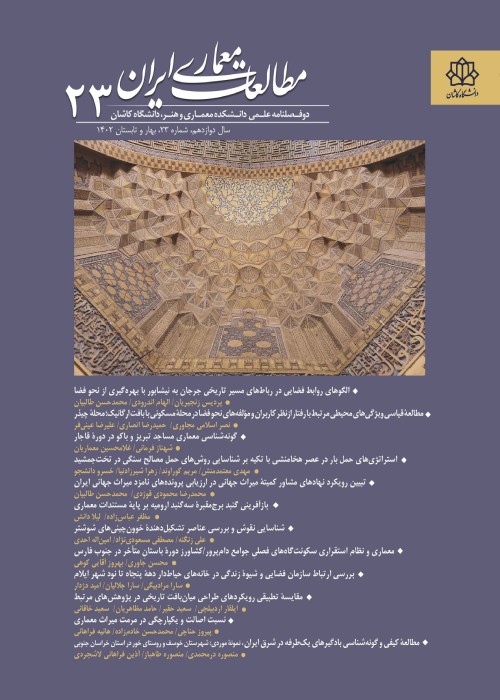Investigation of Brick Arrays of Historical Houses in the City of Behbahan in the Pahlavi Period
Author(s):
Article Type:
Research/Original Article (دارای رتبه معتبر)
Abstract:
In Behbahan historical houses, two types of stone and brick architecture with different structural and decorative patterns can be seen. In brick buildings, which are less old and often date to the late Qajar and Pahlavi periods, bricks have been used in both structural and decorative components. The decorative role of brick was recognized from its early usage, and it has been used as the main ornamentation in Behbahan’s architecture works in different parts of buildings and in different manners. However, few studies have been done on brick decorations, except for brief reports composed during the introduction of some historical monuments; hence, further research is required to introduce such ornamentation. The purpose of this study is to investigate and document the brick decorations of historical houses in Behbahan in order to provide design patterns for use in future studies. Therefore, based on available documents and references, brick ornaments in Iranian architecture were studied first. Next, using field surveys and an analytical-descriptive method, the decorative patterns in the research samples were categorized and the types of bricks used, types of patterns, methods of execution, place of application, and style of decoration were then examined. For this purpose, 28 historical houses and more than 50 frontispieces were studied and 47 patterns were extracted. The results show that brick decorations have often been used for the interior walls of courtyards (exterior walls were not decorated except for the frontispiece, i.e., the entrance). Brick patterns were executed using ornamentation techniques such as khavun-chini, rag-chin (course), gol-andaz, lattice form, and gereh; and various forms of brick cutting were also used especially in edging, framing, and string courses in combination with gol-andaz and rag-chin traceries. The traceries are mainly the result of the repetition of basic patterns. Basic patterns are observed in the form of chevron, five-row flowers, seven-row flowers, nine-row flowers, and eleven-row flowers (simple and combined). The style of decorations is geometric, based on the principle of symmetry in line with the continuity of Iranian brickwork tradition.
Keywords:
Language:
Persian
Published:
Journal of Iranian Architecture Studies, Volume:10 Issue: 20, 2022
Pages:
27 to 48
magiran.com/p2434117
دانلود و مطالعه متن این مقاله با یکی از روشهای زیر امکان پذیر است:
اشتراک شخصی
با عضویت و پرداخت آنلاین حق اشتراک یکساله به مبلغ 1,390,000ريال میتوانید 70 عنوان مطلب دانلود کنید!
اشتراک سازمانی
به کتابخانه دانشگاه یا محل کار خود پیشنهاد کنید تا اشتراک سازمانی این پایگاه را برای دسترسی نامحدود همه کاربران به متن مطالب تهیه نمایند!
توجه!
- حق عضویت دریافتی صرف حمایت از نشریات عضو و نگهداری، تکمیل و توسعه مگیران میشود.
- پرداخت حق اشتراک و دانلود مقالات اجازه بازنشر آن در سایر رسانههای چاپی و دیجیتال را به کاربر نمیدهد.
In order to view content subscription is required
Personal subscription
Subscribe magiran.com for 70 € euros via PayPal and download 70 articles during a year.
Organization subscription
Please contact us to subscribe your university or library for unlimited access!


